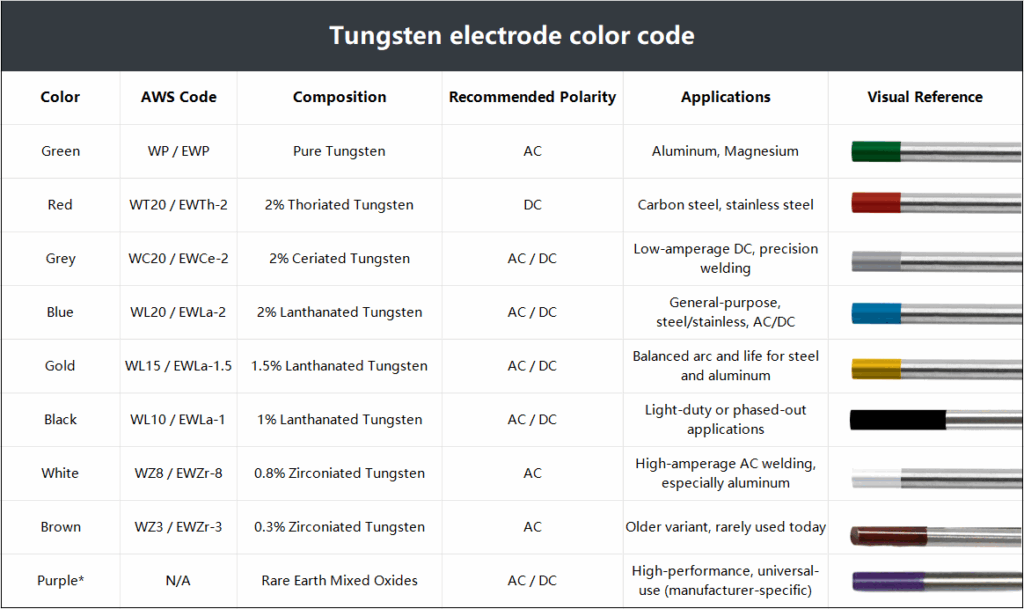In TIG welding, the tungsten electrode acts as a non-consumable conductor and energy transfer point. It bridges the power source and the weld pool, delivering heat through a stable arc without melting itself. This allows for precise control and clean, high-quality welds.
Tungsten electrodes come in different compositions, much like filler wires vary by material. To help welders quickly identify and select the right one, each type is color-coded. But how many types exist, and what do those colors actually mean? Let’s find out.

Tabla de contenidos
PalancaUnderstanding Tungsten Electrode Color Codes
Pure Tungsten Color Code: Green
Contains 99.5% pure tungsten. Offers excellent arc stability on AC. Ideal for welding aluminum and magnesium. Shorter lifespan and lower current capacity compared to alloyed electrodes.
Thoriated Tungsten Electrodes: Red & Yellow
- Red (WT20): Contains 2% thorium. Known for excellent arc starting and DC stability. Common for carbon steel and stainless steel. Though comically weakly radioactive—with a half-life of 1.405×10¹⁰ years—it’s still important to be cautious during grinding. Inhaling metal dust, whether radioactive or not, can be harmful.
- Yellow (WT10): Contains 1% thorium. Similar characteristics as red but with slightly reduced performance. Less commonly used today.
Ceriated Tungsten Electrodes: Grey & Orange
- Grey (WC20): Contains 2% cerium. Suitable for both AC and DC at low amperages. Ceriated electrodes excel at initiating the arc, even with very low current. This makes them especially effective for welding thin sheet metal or delicate components that are sensitive to heat.
- Orange (WC10): Contains 1% cerium. Used for low current applications. Less stable than WC20 and now rarely used.
Lanthanated Tungsten Electrodes: Blue, Gold & Black
Lanthanated electrodes offer the most variety among AWS types, with lanthanum oxide content ranging from 0.8% to 2.2%. This addition helps stabilize the grain structure under heat and improves electron emission. As a result, these electrodes maintain a sharp tip and provide reliable arc starts and performance on both AC and DC.
- Blue (WL20): Contains 2% lanthanum. A popular choice for both AC and DC welding, especially on inverter machines. It delivers a stable arc across materials like aluminum and steel, maintains a sharp tip, and offers excellent all-around performance—at a reasonable cost compared to some other types.
- Gold (WL15): Contains 1.5% lanthanum. Offers a good balance of arc stability and electrode life. Works well for both steel and aluminum.
- Black (WL10): Contains 1% lanthanum. Lower lanthanum content results in reduced performance. Mostly phased out in favor of WL15 and WL20.
Zirconiated Tungsten Electrodes: White & Brown
- White (WZ8): Contains 0.8% zirconium. The addition of zirconium oxide improves arc starts, reduces spitting, and enhances performance under high amperage. White tungsten electrodes are best suited for AC welding, especially for aluminum, where stability and cleanliness are critical.
- Brown (WZ3): Contains 0.3% zirconium. An earlier version with lower zirconium content.
Rare Earth Tungsten Electrodes: Various Colors
Contains a proprietary mix of rare earth oxides like cerium, lanthanum, and yttrium. Designed to combine the benefits of multiple alloy types. No fixed color—varies by manufacturer (often purple or unspecified). Common in high-performance or universal-use applications.
FAQs
Q: Are tungsten electrode rods completely tungsten for the entire length? Or is it just the coloured tip that’s different?
A: Yes, the entire rod is made from the specified tungsten alloy—not just the tip. The colored tip is simply a visual code applied by the manufacturer to identify the composition (e.g., 2% lanthanated, pure tungsten, etc.). The alloy content is consistent throughout the full length of the electrode.
Q: How should I sharpen a tungsten electrode, and are there special considerations for different colors?
Sharpening requires focusing on three tips: the Grind Direction must be axial to stabilize the arc; the Grinding Angle should match your amperage (e.g., 30°-35° for versatility); and always use a small Tip Flat / Truncation to prolong electrode life. See here for additional tungsten electrode grinding techniques.For different colors, always use a specialized grinder with ventilation, particularly for types like red-colored (thoriated) tungsten, due to its low-level radiation risk.

